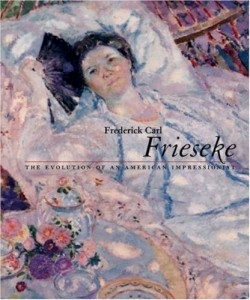Frederick Carl Frieseke
The Evolution of an American Impressionist
Considering Frieseke’s extensive and superb oeuvre of Impressionist paintings, it is surprising that he is so little known, especially in his native United States. A major retrospective exhibition at the Telfair Museum of Art in Savannah, Georgia, along with this accompanying catalogue, are likely to change that status.
Kilmer, Frieseke’s grandson, contributes a well-researched biography, complete with family photographs. He details the artist’s studies with James MacNeill Whistler and other masters; his travels (most importantly his time in Paris and Giverny, France); and his exhibitions and awards, in the United States and Europe. Frieseke conducted a long, loving relationship with Sadie O’Bryan, who became his wife and the mother of his only child, a girl named Frances, the subject of many of his paintings. The artist was fascinated by the effects of sunlight on landscapes and figures, especially on human skin, but he found it a struggle to reproduce the effects to his own satisfaction. Perhaps this striving to create paintings that would live up to his high standards was what led him to produce such ample output.
Frieseke experimented with a range of styles, from almost-monochromatic watercolor landscapes to figures in vivid domestic interiors reminiscent of Whistler and John Singer Sargent. His most striking paintings are of women, clothed or nude, in outdoor settings. In a series done in the mid-1910s, Frieseke places bright, luminous, carefully articulated figures amidst colorful, rapidly rendered flowers, trees, and grasses. The contrasts between the serene, white figures and the wild, lively settings make the paintings shimmer and dance.
Three essays by leading art scholars discuss the artist’s work in historical contexts. H. Barbara Weinberg, who is the Alice Pratt Brown curator of the department of American painting and sculpture at The Metropolitan Museum of Art, focuses on Frieseke’s work before 1910. Art historian and author David Sellin brings to life Frieseke’s years in artist colonies outside Paris. Virginia M. Mecklenburg, senior curator of painting and sculpture at the Smithsonian American Art Museum, describes the artist in transition: “his lengthy concerns with impressionistic light and color giving way to explorations of the universe of the mind.”
The book is well laid out, with a useful timeline of the painter’s life, followed by a series of lovely color plates of the works in the exhibition, in approximately the order in which Frieseke produced them. Details of the paintings are embedded in text that refers to them, along with a number for reference to the plate.
This exhibition and volume should raise Frieseke to his rightful place—alongside the Impressionist masters in the consciousness of art lovers on both sides of the Atlantic.
Reviewed by
Karen McCarthy
Disclosure: This article is not an endorsement, but a review. The publisher of this book provided free copies of the book to have their book reviewed by a professional reviewer. No fee was paid by the publisher for this review. Foreword Reviews only recommends books that we love. Foreword Magazine, Inc. is disclosing this in accordance with the Federal Trade Commission’s 16 CFR, Part 255.

